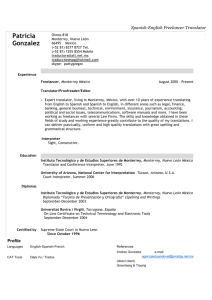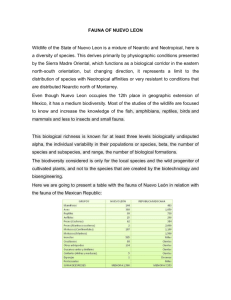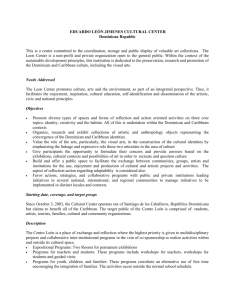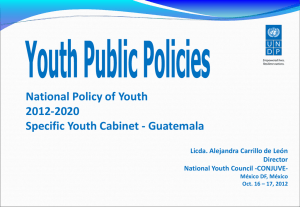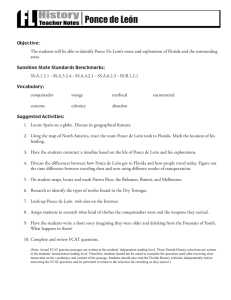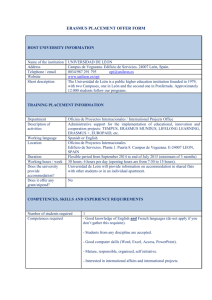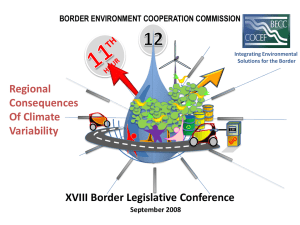region: state of nuevo león, mexico
advertisement
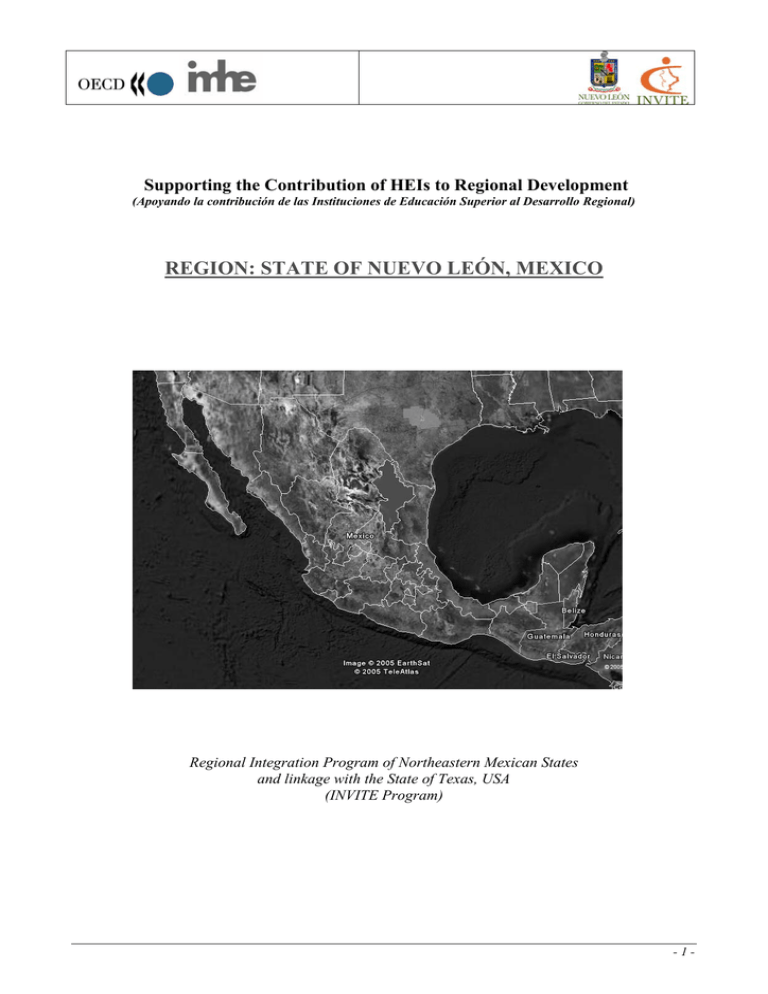
Supporting the Contribution of HEIs to Regional Development (Apoyando la contribución de las Instituciones de Educación Superior al Desarrollo Regional) REGION: STATE OF NUEVO LEÓN, MEXICO Monterrey, NL. México January, 2005 Regional Integration Program of Northeastern Mexican States and linkage with the State of Texas, USA (INVITE Program) -1- REGION: STATE OF NUEVO LEÓN, MEXICO The State of Nuevo León, and its capital city, Monterrey, are located at the North-eastern region of México; Monterrey is considered the most important financial and industrial center, as well as the must port of entry for the commercial exchange between the Northeastern Region of México and the United States. a) For the purpose of this case of study, the project will be focused just on the HEIs of the Nuevo León region instead of the whole North-eastern Region (4 states of México and the State of Texas, USA) b) Because of the INVITE Program’s objective, this project will include issues of cross-state collaboration and crossborder collaboration with other 3 States of México and Texas (i.e. how to enhance the collaboration with other states in México and Texas in the US from the perspective of the Nuevo León Region) c) For practical purposes and the alignment to the study's focus, as well as considering the number and basic differences (i.e. size, academic programs, infrastructure, etc.) of the HEIs at the Nuevo León region, the project will be narrow to manageable number of HEIs REGIONAL CO-ORDINATOR Name: Address: Tel: Fax: E-mail: Name: Address: Tel: Fax: E-mail: Dr. Romeo Flores Caballero, Executive Coordinator Regional Integration Program of North-eastern Mexican States and linkage with the State of Texas (INVITE Program), Government of the State of Nuevo León José Benítez #2709, Col. Obispado, Monterrey, NL. México, CP 64060 +52 (81) 1133-8344 +52 (81) 1133-8342 romeo.flores@nl.gob.mx Lic. Amanda Ortiz, Strategic Programs Coordinator Regional Integration Program of North-eastern Mexican States and linkage with the State of Texas (INVITE Program), Government of the State of Nuevo León José Benítez #2709, Col. Obispado, Monterrey, NL. México, CP 64060 +52 (81) 1133-8329 +52 (81) 1133-8342 amanda.ortiz@mail.nl.gob.mx -2- Regional Characteristics Geopolitical Features Municipalities and Territory Total Population Economically Active Population State of Nuevo León • • • • • • • Economic Importance • • • • • Geopolitical, Demographic and Economic Structure Infrastructure • • • • • • Government System • • Total extension 64,555 Km2; 3.3% of national. 51 Municipalities (counties). Capital City: Monterrey. Population 4.2 Millions; 3.9 % of the country. 85% of the population is located in Monterrey and its Metropolitan Area. Ranked the 3rd. largest city in México. 1.81 million (43%). Nuevo León is the 3rd. economy of México. Monterrey City is considered the most important financial, commercial and industrial center of the North Region. State’s GDP: 45.5 BD; 7.2% of the national. Per Capita Income $11,149 USD per year, which exceeds 84% the national average ($6,042 USD) Exports of $8,842 MD; 5.3% of the national. Direct Foreign Investment 1,058 MD; 9.08% of the national. Main Economic Sectors: Food, Beverages (with international presence in the beer industry), Cement (CEMEX-the 2nd. largest corporative worldwide market), Chemicals, Automotive, Steel, Glass, Gas (Burgos Basin, main reservoir of not associated gas basin of the country). 4,226 km. of Highways 1,091 km. of Railroads 2 International Airports 1 International México-USA Border Bridge, “Colombia”, considered the 4th. most important of México. Infrastructure in communications, transportation, energy, gas and coal deposits, sufficient power generation plants. Considered the industrial capital of México Representative Democracy, integrated by the Executive, Legislative and Judicial branches. Political parties: PRI, PAN, PRD, PT, Verde, and Convergencia -0- Characteristics of the HEIs in the Region • • • • • • • • México is a relative young country. 50% of its more than 100 Million inhabitants oscillate between 5 and 29 years old. The State of Nuevo León has 4.2 millions, and same demographic structure. The school enrollment exceeds 29 Millions of students. In Nuevo León, the student enrollment exceeds the 1.19 millions, attended in 5,561 institutions. México has 3,812 HEIs that serve 2,239,100 students. - 2,032, (53.31%) are public and attend the 67% of the student population - 1,780 (46.69%) are private and attend the 33% of the student population. The State has 43 HEIs, representing the 1.13% of the national. 4 public universities serve to 59,865 students (61% of the total of enrollments in HEI). The largest public university is the Universidad Autónoma de Nuevo León (UANL), which concentrates the 94.42% (56,503 students). In a global context, the national public university system serves 2,239,100 students, 67% of the total. In Nuevo León, the 8.6% (9,602) of undergraduate students enrolls in a graduate program; representing the 5.8 % of the total population of graduate students in México, which is 129,867. Nuevo León has more than 500 scientist recognized as members of the National Research System for (SNI), that represent the 4.9% of the nation (10,189). The budget for education in México is 38 BD (6.2% of the GDP). In Nuevo León adds up to 2.6 BD (6% of the State’s GDP); the total budget is integrated by the state contribution of 1.3 BD (3% of the State’s GDP) and a similar amount from Federal Government sources. Although Mexico’s budget dedicated to education exceeds the average of the OECD´s members, our country is ranked 34th (of 41 countries) in educational efficiency. According to the OECD´s Economic Survey of México 2005, our country is delivering inefficient and inequitable the educational services. At the same time, México occupies the lowest media average in Mathematics and Reading Skills. A Brief History of HEIs' Engagement in the Regional Development; The actual situation of education in Mexico reflects the inefficiency of the educational system, which does not contribute to eliminate poverty, does not solve the inequalities, and does not increase competitiveness. According to the World Economic Forum, Mexico is ranked 55th in competitiveness. Nevertheless, it is important to focus on Nuevo León region and to recognize the individual efforts that its universities, especially the 3 most important universities of the state, Universidad Autónoma de Nuevo León (UANL), ITESM and Universidad de Monterrey (UDEM) have made in order to contribute the regional development. Besides the natural incorporation of computer and information systems as part its teaching-learning process, most of the universities have also incorporated social and community programs; technical and practical internship with business and industry; and training and continuing education programs, into the students curricula activities, in order to respond to the business and industrial sector’s needs. However, despite all the federal and states efforts made in the Higher Education System, such as the increasing investment in education and the increasing enrollment of students, it is important to consider the actual existence of some irregularities in the whole system. The most critical is that the educational system still being “invertebrate”. The absence of articulation between all different education levels, as well as the lack of linkages between the educational and economic systems, could explain the limited research and scientific development, and the high rate of professional unemployment and under employment. -1- As a consequence of this, the increasing investment in education does not reflect the quality of the teaching and learning process. And the increasing enrollment of students dissolves the efforts to increase the educational budget. At the same tome the Teachers Union does not contribute to increase the quality of educational policy; and the real shortage budget and the non supportive influence of the Teachers Union are limiting the training of qualified professors and the adequate selection of pedagogical materials aids and equipment to increase the quality of education. The Scope and Level of Involvement of Regional Stakeholders in the Project In order to impulse the scientific and technological research, the State Government created in November 2003, the Corporation of Strategic Projects of Nuevo León and five strategic projects; two of these projects are: • The Regional Integration Program of the Northeastern Region Development and its linkage with Texas (INVITE) • The Monterrey International Knowledge City These projects have realized a diversity of projects and programs in collaboration with academic and state government institutions, as well as the private sector of Nuevo León, the Northeastern Region and Texas. Recently, the State Government, trough the creation of the Program “Monterrey International City of Knowledge” (in March 2004) and the Technological Park (in June 2005), has established the commitment of the National Board of Science and Technology (CONACYT) and the three most important universities of the state, to promote innovation and technology development in the most strategic areas of the region. As a result of this commitment, 16 new research centers will be created in the State: - CONACYT (5): Feeding and Development; Advanced Materials; Engineering and Industrial Development; and Scientific Research and Higher Education. - UANL (2): Which actually is strongly contributing innovation, research, science and technological development through 38 laboratories and 18 research centers, will create 2 new research centers: Research and Development in Health Sciences and Innovation, Research and Development in Engineering and Technology. - ITESM (6): Which is promoting different programs for nanotechnology, medicine, biotechnology, mechatronics, robotics and airspace industry through its 33 research centers, will create 6 new research centers for: Advanced and Alternate Materials for Construction; Cybersecurity; Utility Data Center; Informatics; Software Development; and MEMS Technology. - UDEM (3): Innovation and development for Small and Media Business; Research and Innovation of Products, Packages and Packing; and Legal Studies for Industrial Property. Resources for Further Information on the Region Î Region States’ Government sites: • Nuevo León: http://gobierno.nl.gob.mx/ • Monterrey International Knowledge City Program: http://www.mtycic.com.mx/index3.htm • Minister of Education: http://www.nl.gob.mx/?P=sec_educacion • Minister of Economic Development: http://www.nl.gob.mx/?P=sec_des_economico Î e-México INEGI - Estadísticas sociodemográficas: http://www.e-mexico.gob.mx/wb2/eMex/eMex_INEGI__Estadisticas_sociodemograficas -2- ♦ The Regional Integration Program of North-eastern Mexican States and linkage with the State of Texas (INVITE Program) The INVITE Program was created on March 2004 by the Governor of the State of Nuevo León, Dr. José Natividad González Parás, with the vision to achieve, within the Constitutional framework, the economic integration and the cooperation in social, ecological and cultural matters, of the Northeastern Mexican States of Nuevo León, Chihuahua, Coahuila and Tamaulipas, with Texas. The Mission of the program is to impulse the second stage of the North American Free Trade Agreement, and it has become one of the most important structures of the Nuevo Leon’s Government for the creation and establishment of collaborative partnerships between academic, industrial and governmental institutions from the North-eastern Region of Mexico (Chihuahua-Coahuila-Nuevo León and Tamaulipas States) and the State of Texas, USA INVITE´s Objectives • To consolidate the regional economic integration between Northeast Mexico and its linkage with Texas. • To design and establish long-standing public policies on economic, environmental, and social matters. • To promote the development of strategic economic zones. • To encourage the participation of the domestic and international Public and Private sectors in the development of the region. • To impulse and strengthen research and investment for the development of state-of-the-art technology and engineering in the Region. • To generate a new northeast border culture of integration and economic, academic, and social cooperation. What are we aiming at? • Increase competitiveness • Strengthen comparative advantages • Standardize public policies • Impulse economic growth • Improve social welfare levels • Exploit scale economies • Efficiently use productive recourses -3-
